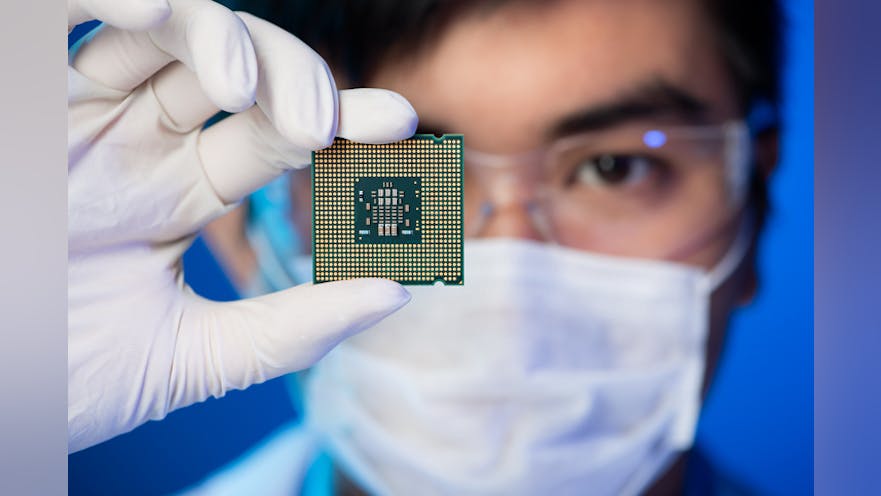Three Technologies U.S. Defense Agencies Are Using to Battle Counterfeit Chips
As U.S. imports of semiconductors and related devices have continued to surge in recent years, so too has the threat of counterfeit electronics components entering the supply chain.
And while the risk of using a laptop or tablet with a faulty chip installed might involve only a loss of data or functionality, military and medical applications built with compromised electronics can risk death. That’s one reason why the U.S. defense sector has taken a lead role in investing in new technologies to test and authenticate electronic components.
A 2011/2012 Senate Armed Services Committee investigation helped bring the issue to the forefront. The committee identified approximately 1,800 instances of suspect counterfeit parts in the defense supply chain. Those parts were supplied by more than 650 companies, each of which relied on its own network of suppliers.
A review of test reports associated with the suspect counterfeit parts further revealed “wide disparities in testing used by companies in the defense supply chain.” Some companies required, for example, exposing a part to aggressive solvents to determine whether markings were authentic or delidding part samples to examine the die. Other companies, the Committee found, were willing to accept components that had been subject to only “basic functional testing.”
The investigation also revealed deficiencies in the processes used to determine whether and how parts were tested. In one case involving counterfeit memory chips sold to L-3 Communications, a Chinese supplier sent the company’s U.S.-based distributor a sample of 18 parts to test. After testing had validated the sample as authentic, L-3 purchased more than 10,000 chips without additional testing from an independent laboratory.
While the U.S. Department of Defense has since published rules detailing the procedures that contractors should follow to help prevent counterfeit electronic parts from entering the defense supply chain, a number of agencies are now also working to develop new counterfeit prevention and detection technologies. If they prove successful—and can be made commercially available at a low-enough price point—these techniques could help secure supply chains for consumer electronics and other civilian applications.
1. Plant DNA Marking
Since 2010, the Defense Logistics Agency—the Pentagon’s procurement arm—has worked with biotechnology firm Applied DNA Sciences to incorporate the company’s marking technology on its electronics and other parts. The proprietary technology involves rearranging DNA derived from plants into unique sequences that are encrypted and affixed to batches of chips or other components to establish their authenticity.
Customers can quickly confirm the existence of the DNA by shining a light on the component, which will cause the mark to fluoresce. Authentication of the part as genuine requires swabbing the DNA and submitting it for forensic analysis. According to Applied DNA Sciences, any ablation, blacktopping, sandblasting, or refurbishing of the chip will distort or remove the DNA mark, “a sure tripwire within the authentication work flow.”
In addition to microcircuits, the company says its DNA taggants are capable of demonstrating supply chain integrity for a range of other electrical and electronic components, as well as gaskets and o-rings, bearings, pipes, tubing, and hoses.
2. Optical Scanning
A separate investigation exploring DNA’s use as a tagging and tracking method—by the U.S. Army Research Laboratory and Army Research Office—has meanwhile led to the development of an optical scanning technology that can assist in identifying counterfeit electronic components in the absence of external barcodes or tags.
Initially, the Army contracted California-based ChromoLogic LLC to study the properties of DNA with the goal of determining whether it could be used in a barcoding system that could improve security beyond that of conventional tracking methods. The company devised a tag with a biomimetic barcode that could be decoded by an optical reader in similar fashion to how the sequence of a DNA molecule can be read.
However, the ChromoLogic researchers, led by Dr. Naresh Menon and Leonard Nelson, further discovered that the optical scanning technology developed to decode the biomimetic tag was capable of mapping electronic components’ surfaces to provide a type of fingerprint to distinguish authentic from counterfeit circuits.
According to the Army, because counterfeit electronic components are forged primarily by altering their surface layers, the discovery provides a method for screening integrated circuits based on their “intrinsic surface patterns,” which can be scanned in as little as one second.
ChromoLogic has developed the surface-scanning technology into the DTEK system, which provides optical inspection of integrated circuits. DTEK has already been adopted by both Boeing and NASA’s Jet Propulsion Laboratory as part of their inspection processes.
3. DARPA Shield
The Defense Advanced Research Projects Agency (DARPA) embarked on an ambitious program in 2014 to develop a tool to verify the trustworthiness of protected electronic components without harming or disrupting them. DARPA's Supply Chain Hardware Integrity for Electronics Defense (SHIELD) program aims to develop a small (100 micron x 100 micron) “dielet” that can authenticate the provenance of electronic components.
According to the agency, the dielet would be inserted into the part’s package at the manufacturing site or affixed to existing “trusted” components—without any electrical connection between the dielet and the host component and without altering the host component’s design or reliability. Authenticity testing could be performed with a hand-held or automated probe.
DARPA says probes would need to be close to the dielet for scanning—after which an inexpensive appliance, such as a smartphone, could upload a serial number to a central, industry-owned server. The server would send an unencrypted challenge to the dielet, which would send back an encrypted answer and data from passive sensors, such as a light, that could indicate tampering.
“SHIELD demands a tool that costs less than a penny per unit, yet makes counterfeiting too expensive and technically difficult to do,” says Kerry Bernstein, DARPA program manager. “The dielet will be designed to be robust in operation, yet fragile in the face of tampering.”
Northrop Grumman is leading a team to develop the dielets, which are intended to be made commercially available in 2019.
“We are on track to build the world’s smallest highly integrated computer chip,” adds Bernstein. “If we succeed, then an untrained operator at any place along the supply chain will be able to interrogate the authenticity of any component used by the Defense Department or in the commercial sector and get high-confidence results back immediately, on site, securely, and essentially for free.”
















